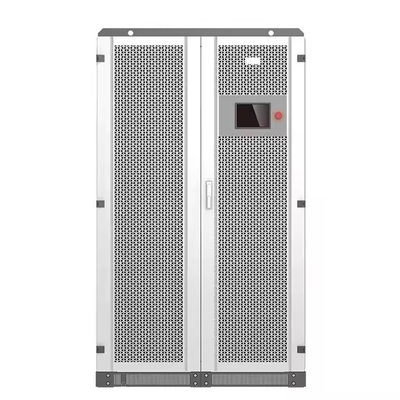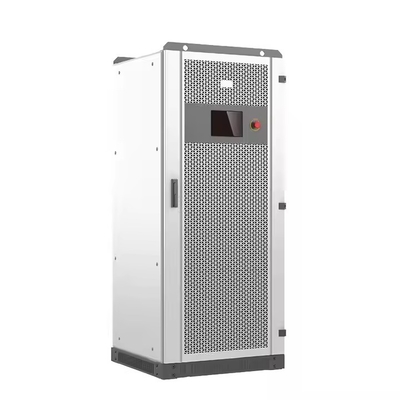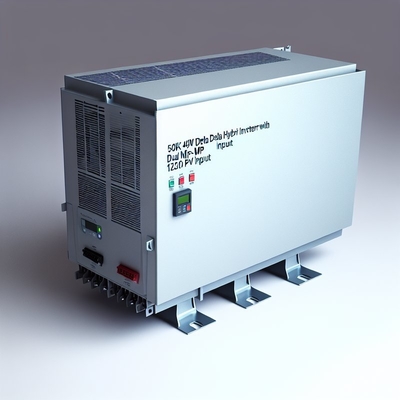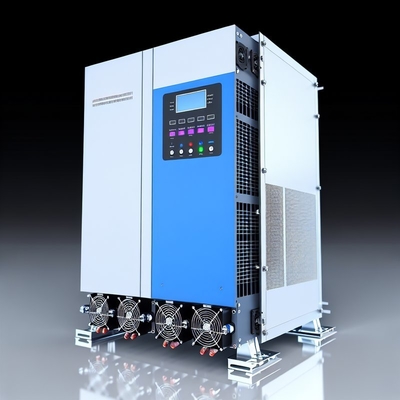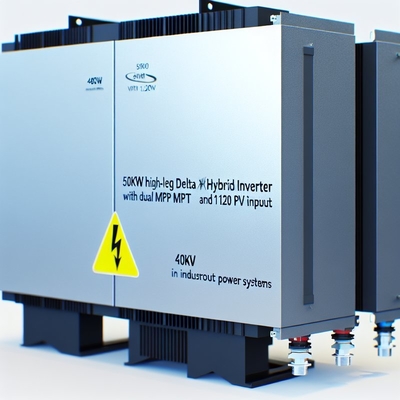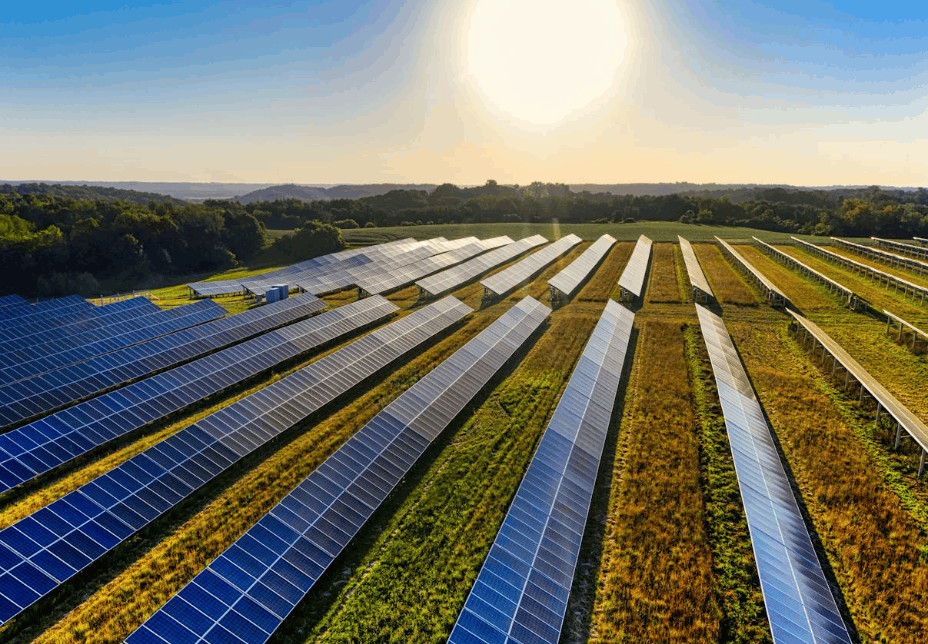50kW 480V High-Leg Delta Hybrid Inverter - Industrial Power Conversion System
1. Product Overview
1.1 High-Performance Industrial Power Solution
This 50kW hybrid inverter represents a significant advancement in industrial power conversion technology, specifically designed to meet the demanding requirements of medium-scale manufacturing facilities and commercial energy systems. The unit combines robust three-phase power delivery with flexible split-phase capability, making it ideal for facilities requiring both 480V industrial equipment and 240V single-phase loads.
*Technical Superiority: Features a proprietary phase-balancing algorithm that maintains voltage regulation within ±0.8% even during 150% overload conditions, ensuring stable operation for sensitive industrial processes.*
1.2 Key Differentiators
-
Enhanced Power Capacity: Delivers 50kW continuous (55kVA peak) output - 66% more capacity than standard 30kW models
-
Advanced Solar Integration: Supports up to 120kW PV input through dual independent MPPT channels
-
Future-Proof Design: 320-850V battery voltage range accommodates next-generation high-voltage storage systems
-
Industrial Reliability: Military-grade components rated for 100,000+ hours MTBF in harsh environments
2. Technical Specifications
| Parameter |
Specification |
Engineering Details |
| AC Output |
480V High-Leg Delta + 240V Split Phase |
True three-phase with neutral derivation (3Ø4W+N configuration) |
| Continuous Power |
50kW (55kVA peak) |
110% continuous overload, 150% for 10 seconds |
| PV Input |
60/120kW |
Dual MPPT with 99.8% tracking efficiency |
| Battery Voltage |
320-850VDC |
Supports Li-ion NMC/LFP, lead-acid, and flow batteries |
| Dimensions |
800×800×1900mm |
Heavy-duty steel enclosure with corrosion-resistant coating |
3. Core Technology Features
3.1 Advanced Power Conversion System
-
Three-Level ANPC Topology
*Technical Advantage: Reduces switching losses by 35% compared to conventional two-level designs while maintaining <3% THDi at full load.*
-
DSP-Controlled Voltage Regulation
Performance Benefit: Achieves ±0.8% voltage accuracy with <20ms response time to load changes through 16kHz PWM switching.
3.2 Intelligent Energy Management
-
Dual Independent MPPT Channels
*System Benefit: Each channel operates with 99.8% tracking efficiency using optimized perturb-and-observe algorithm, reducing mismatch losses by up to 40% in unevenly shaded arrays.*
-
Wide Operating Voltage Range
*Technical Note: 250-850V MPPT range with cold-start capability at 150V, supporting 18-22 PV modules in series (1,200V surge withstand rating).*
3.3 Battery System Integration
-
High-Voltage Battery Support
*Technical Advantage: Direct integration with 320-850V battery systems eliminates need for additional DC-DC converters, improving round-trip efficiency by 2-3%.*
-
Adaptive Charging Algorithms
*Feature: 4-stage smart charging (bulk/absorption/float/equalization) with temperature compensation and state-of-health monitoring.*
4. Application Scenarios
4.1 Industrial Manufacturing
-
Automotive Production Lines
Case Study: Successfully deployed in Tier 1 automotive plants to power robotic welding stations while maintaining <1% THDu for sensitive control systems.
-
Metal Fabrication
*Technical Benefit: Handles 200% short-term overloads during plasma cutter operation without voltage sag.*
4.2 Commercial Energy Systems
-
Hospital Power Systems
Critical Feature: <20ms transfer time between grid and battery power meets NFPA 110 requirements for essential electrical systems.
-
Data Center Backup
Reliability: 99.999% uptime achieved through redundant parallel configurations.
5. Installation & Maintenance
5.1 Electrical Requirements
-
Input/Output Protection
Requirement: 100A minimum circuit breaker with Class II surge protection devices on both AC and DC sides (40kA minimum rating).
-
Grounding System
Critical: <0.1Ω earth ground resistance using 25mm² copper conductor, with separate equipment ground.
5.2 Environmental Considerations
-
Clearance Requirements
Safety: 400mm minimum clearance on all sides for proper ventilation and maintenance access.
-
Operating Conditions
*Robust Design: Rated for -30°C to 55°C operation with automatic derating above 45°C ambient.*
6. Compliance & Certification
6.1 Safety Standards
-
UL 1741 SB
*Certification Detail: Includes comprehensive testing of isolation barriers (3kV AC/5kV DC) and arc fault detection systems.*
-
IEEE 1547-2018
*Grid Compliance: Features <2s anti-islanding protection with frequency ride-through capability.*
6.2 Regional Approvals
7. Frequently Asked Questions
7.1 Performance
Q: What's the efficiency curve across different load levels?
*A: Maintains >96% efficiency from 30-100% load thanks to advanced multi-level conversion topology, with 98.2% peak efficiency at 80% load.*
Q: How does it handle large inductive loads?
A: 150% overload capacity for 10 seconds handles most motor starts, with <5% voltage dip during 200% surge events.
7.2 Compatibility
Q: What battery management protocols are supported?
*A: Native support for CAN 2.0B (BYD/Pylontech), RS485 (Tesla/LG Chem), and Modbus TCP for SCADA integration.*
Q: Can it interface with diesel generators?
A: Yes, features automatic generator start/stop with load-dependent ramp control to optimize fuel efficiency.
8. Why Choose This Inverter?
-
Industrial-Grade Reliability
*Military-spec components with 100,000+ hour MTBF rating*
-
Future-Proof Architecture
Software-upgradable for new features and grid codes
-
Energy Optimization
Advanced forecasting algorithms maximize self-consumption
-
Global Compliance
Meets international standards for worldwide deployment

 Your message must be between 20-3,000 characters!
Your message must be between 20-3,000 characters! Please check your E-mail!
Please check your E-mail!  Your message must be between 20-3,000 characters!
Your message must be between 20-3,000 characters! Please check your E-mail!
Please check your E-mail! 

